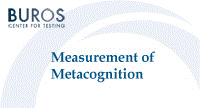Buros-Nebraska Series on Measurement and Testing

Issues in the Measurement of Metacognition
Date of this Version
2000
Document Type
Article
Citation
Published in Issues in the Measurement of Metacognition, ed. Gregory Schraw & James C. Impara (Lincoln, NE: Buros Institute of Mental Measurements, 2000).
Abstract
Metacognition refers to thinking about thinking, or more generally, to using higher-level knowledge and strategies to regulate lower level performance. Previous research suggests that metacognition is an important part of learning among adults (Baker, 1989; Garner & Alexander, 1989; Pressley & Ghatala, 1990) and children (Alexander, Carr, & Schwanenflugel, 1995; Borkowski & Muthukrishna, 1992). Metacognition contributes to learning in several ways, but especially by helping learners to use their attentional resources more efficiently, to process information at a deeper level, and to monitor their performance more accurately.
Notwithstanding its importance, there is considerable debate regarding how to measure meta cognition. At the heart of the problem is the elusive nature of metacognitive knowledge itself. Most theorists assume meta cognitive knowledge is highly abstract and cuts across domain-specific boundaries (Brown, 1987; Flavell, 1987; Paris & Byrnes, 1989; Schraw, Dunkle, Bendixen, & Roedel, 1995; Schraw & Moshman,1995). In contrast, most declarative and procedural knowledge in memory is welded to a specific domain, and can be stated as a declarative fact or demonstrated through a procedure. As a result, declarative and procedural knowledge are much easier to identify, manipulate, and measure than metacognitive knowledge. Added to this is the fact that metacognitive knowledge is acquired gradually over long periods of time, emerges relatively late in development, and often is difficult to explicate even when an individual demonstrates a high degree of metacognitive competence (Brown, 1987; Garner, 1994; Weinert & Kluwe, 1987).
Another problem is that metacognitive processes such as planning and evaluation are difficult to measure directly.
For this reason, researchers have relied on a variety of indirect measures such as verbal reports, think-alouds, self-report inventories, and subjective measures of performance accuracy. One consequence of the unobservable nature of metacognitive knowledge and regulation is that researchers have focused their attention on several specific aspects of metacognition that are easier to measure than others, especially various forms of monitoring. Most studies have focused on memory monitoring (Cavanaugh & Perlmutter, 1982; Johnson, Hastroudi, & Lindsay, 1994; Lovelace, 1984; Koriat, 1993; Schneider & Pressley, 1989), comprehension monitoring (Glenberg & Epstein, 1985; Leonesio & Nelson, 1990; Weaver, 1990), or performance monitoring (Glenberg, Sanocki, Epstein, & Morris, 1987; Pressley & Ghatala, 1990).
This chapter addresses problems related to the measurement of metacognition in greater detail. We believe that some of the more imposing obstacles can be addressed successfully via computer-based testing procedures, but especially those pertaining to the assessment of metacognitive control processes. We will argue that computer based testing provides opportunities for researchers to measure control processes with much greater precision than with non-computerized methodologies. Computer-based testing enables us to do so in an unobtrusive, reliable manner that is less apt to be confounded by pre-experimental knowledge and ability.
The remainder of this chapter is divided into six sections. The first of these provides a brief overview of previous research and presents a multilevel model of metacognition that distinguishes between two major components, including knowledge about and regulation of cognitive processes and knowledge. We further distinguish between two sub-components of meta cognitive regulation, including meta cognitive control and monitoring. Control processes are used to select performance goals and guide ongoing cognitive activities. Monitoring processes are used to evaluate the present success of one's performance and the degree to which one has met one's long-term performance goals. We assume that control and monitoring are reciprocally linked in a manner that facilitates self-regulation during performance.


Comments
Copyright © 2000 Buros Institute of Mental Measurements. Digital Edition Copyright © 2012 Buros Center for Testing.